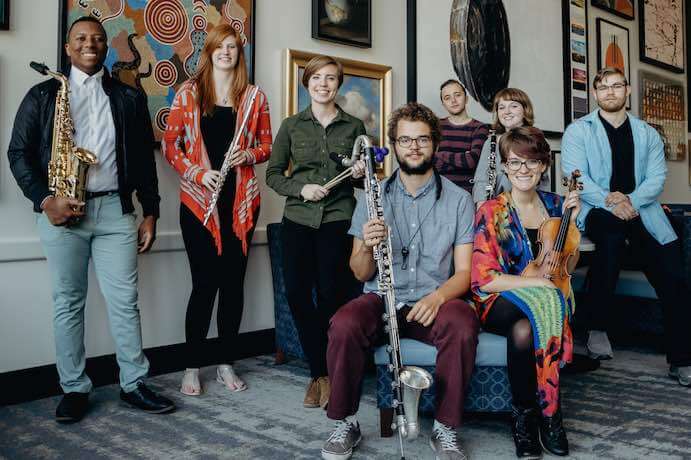Over the past 11 years the Grand Valley State University New Music Ensemble, under the directorship of Bill Ryan, has established itself as a veritable institution in the new music community. The accolades and glowing reviews the group has garnered for its ambitious touring, recording, commissioning, and outreach activities rival that of professional new music ensembles. Return, the ensemble’s latest album, featuring works by Billy Ryan’s former students was recently reviewed by NPR’s First Listen. In this review, Tom Huizenga calls the works on the album, “a fascinating hybrid weave of surprising sounds and fluid borders between unadorned instruments and their processed counterparts.”
It was quite fortuitous that as I was assigned this interview with you that the NPR review of Return was published. Could you further comment on the process of making this album and how it compared both procedurally and emotionally to the ensemble’s previous recording projects?
The most exciting part of this album for me is that it is entirely home grown. All the music was composed by three composer alumni, performed and recorded by current students. The album brought together all my GVSU worlds, something I’ve been hoping for since I started here in 2005. In terms of the process, the composers sent us short compositions and sketches that we rehearsed and recorded. They would make modifications, send us new material, and the process repeated. Once they had a large collection of recorded material, they went to work in their studios manipulating the recordings into compositions that ended up on the album. In some cases, much of what we originally recorded is apparent, and in others it has been transformed into something we couldn’t have imagined.
The GVSU New Music Ensemble performs Daniel Rhode’s dearest rewinder these from their new album RETURN.
You have undertaken a number of really interesting commissioning projects with the ensemble in recent years. The two National Parks Projects in 2014 and 2016 stood out to me in particular as they seem to implicitly address the increasingly important issues of conservation, ecology, and awareness of our natural world. With that, what directions or themes do you hope to explore with the ensemble’s commissioning projects in the coming years?
Commissioning music has always been a priority. There is no better way to teach than to use the entire commissioning process as the foundation for learning. This album brings us to over sixty commissions since 2006. I’m hoping to do another installment of our National Parks project in 2018, and I have many other ideas for projects. There are many composers I have my eye on that I would love to work with, but the biggest obstacle is to locate funding.
Some of the ensemble’s most recent projects have delved deeply into various types of media in both performance and documentation. How do you view the role of media in these different settings and do you see that role changing in the coming seasons?
A lot of what we do is to prepare students for diverse performance opportunities after GVSU. Much of that could involve technology in some way, which is why all ensemble members learn how to set up their microphones, use a click track, and especially wrap an audio cable. We perform with video, live dance, live electronics, actors, artists, and poets, all with the goal of making the students comfortable in any performance situation. Video is becoming increasingly important, so they will need to be very comfortable not only on the performing side, but also able to produce content to document and promote themselves.

Education and training of students for a variety of careers and roles in music is one of the primary missions of the GVSUNME. What are the most important educational and developmental goals you have for the ensemble each year and how do you achieve them?
All of my teaching centers around graduating students that take personal responsibility for all aspects of their lives, to be strong advocates for whatever they believe in, to be continually curious, and above everything else, be compassionate, supportive, and kind human beings. These are tall and broad goals, but I believe pursuing this is the reason the ensemble has been so successful. I’m trying to raise my own children like this, so why not my students?
Do you have any advice or guidance to offer collegiate institutions looking to begin or expand the mission of their new music ensemble?
First, you need an environment that will support the ensemble—a new music ensemble should not be a club or an extra activity that faculty squeeze onto their other teaching load responsibilities. It will never flourish this way. Instead, faculty need to be given credit so directing an ensemble is part of their teaching load, and recognized in the curriculum so students can at least enroll for chamber music or elective credit. Secondly, the director needs to be pretty selfless when it comes to the ensemble. Besides rehearsing and performing there are countless other responsibilities, much of them mundane. You need a director that will enthusiastically tackle all aspects of this, and won’t hesitate getting dirty in the process. The rewards of having a new music ensemble in a program are numerous, and there is a tremendous support network of professional composers and performers out there that will take notice and talk about any ensemble that is advocating for the music of our time. It’s a built-in marketing machine that will spread word of the group, the school, and most importantly, the music.
























